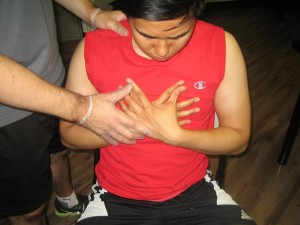It is important to note that chest pain is commonly experienced by many individuals but it can be quite frightening and can indicate a warning that something serious is taking place in the body. Generally, the chest pain can originate from the musculoskeletal system, lungs, heart, digestive system or the circulatory system. With each bodily system or organ, it is vital to bear in mind that there are specific and uncommon causes of chest pain.
Musculoskeletal conditions
The chest pain that originates from the bones, muscles, connective tissues and joints can be due to trauma to the chest such as during a fall or vehicular accident. The strain on the chest muscle due to overuse can also cause chest pain. This often occurs if an individual who is inactive engages in rigorous activity abruptly. The chest pain can also develop due to an autoimmune condition such as lupus. Once the condition flares-up, it can lead to inflammation in the tissues that connects the ribs to the sternum.

Lung issues
There are various lung conditions that can lead to chest pain particularly pneumonia. Other symptoms can include fever, shortness of breath and cough. In most cases, the condition is confirmed with a chest X-ray.
Lung cancer is a less common yet serious lung disease that can cause chest pain. Always remember that smoking is a major risk factor of the condition. The pain linked to lung cancer typically evolves in a gradual manner and can be linked with shortness of breath, weight loss, fatigue and coughing up blood.
Digestive system conditions
There are a number of digestive issues that can cause chest pain and the most common is heartburn. The acid produced by the stomach backs up into the esophagus which is situated in the chest cavity close to the back. Take note that the acid can cause the burning chest pain.
The less common cause of chest pain is diffuse esophageal spasm in which the muscles in the esophagus go into an uncoordinated spasm and trigger acute, extended or oftentimes severe chest pain. Due to the duration and severity of the condition, the doctor will rule out other serious conditions such as a heart attack before a diagnosis is made.
Heart and circulatory conditions
The common heart condition that causes chest pain is angina. The pain is usually experienced in the middle or left side and can radiate to the arms, back, stomach or jaw. It can be accompanied by nausea and sweating and tends to worsen during activity.
Considerations to bear in mind
Always bear in mind that unexplained chest pain should be carefully assessed by a doctor. It is important to note that there are indications that should prompt the individual to seek medical care right away such as central chest pain that radiates to the arms, back, jaw or stomach along with sweating, nausea, vomiting, abrupt tearing chest pain that radiates to the back and chest pain linked with shortness of breath or fever. You can learn more about this condition by enrolling in a first aid class today.
